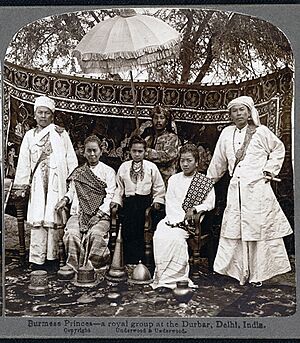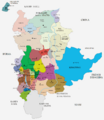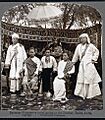Shan States facts for kids
Quick facts for kids
Shan States
British Shan States
|
|||||||||||
|---|---|---|---|---|---|---|---|---|---|---|---|
| 1215–1885 1885–1948 1948–1959 |
|||||||||||
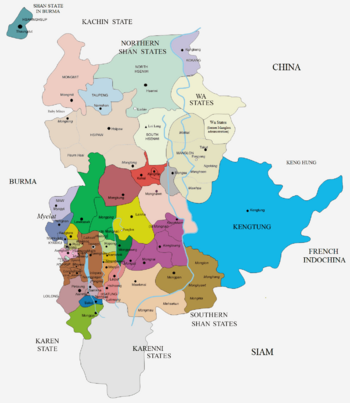
Map of the Shan States
|
|||||||||||
| Status | Princely state (1215–1885; 1948–1959) British Protectorate (1885–1948) |
||||||||||
| Capital | Mogaung | ||||||||||
| Common languages | Shan, Burmese | ||||||||||
| Religion | Theravada Buddhism, animism | ||||||||||
| Government | Monarchy | ||||||||||
|
|||||||||||
The Shan States were a group of small kingdoms in what is now Myanmar (Burma). These kingdoms were ruled by leaders called saophas. They were similar to the princely states found in British India.
The name "Shan States" became popular during the time of British rule in Burma. It described specific areas of Burma. For example, the Federated Shan States included today's Shan State and Kayah State. Sometimes, "Siamese Shan States" referred to Lan Na (northern Thailand). "Chinese Shan States" meant Shan areas in southern Yunnan, like Xishuangbanna.
The Shan people have lived in the Shan Hills and northern Burma since at least the 10th century AD. The first major Shan State in Burma was founded in 1215 at Mogaung. This was part of a larger movement of Tai people who also created the Ahom Kingdom in 1229 and the Sukhothai Kingdom in 1253.
Shan power grew after the Mongols took over the Pagan Kingdom in 1287. The Shan people then controlled many areas from northwestern Sagaing Division to the modern-day Shan Hills. These new Shan States were home to many different ethnic groups. These included the Chin, Palaung, Lisu, Pa-O, Kachin, Wa, and Burmans.
The Shan States were very important in the politics of Upper Burma from the 13th to the 16th centuries. Strong Shan States like Mogaung, Mongyang, and Hsenwi often attacked Upper Burma. In 1364, Mogaung ended the kingdoms of Sagaing and Pinya. Later, a group of Shan States led by Mohnyin captured the Ava Kingdom in 1527. They ruled Upper Burma until 1555.
However, the Shan States were often divided. This made it hard for them to fight off bigger neighbors. In the north, the Chinese Ming dynasty took over today's Yunnan in the 1380s. In the south, the Toungoo dynasty conquered all the Shan States that would become known as Burmese Shan States by 1557. Even though the Shan States were under the rule of Burmese kingdoms, their saophas (chiefs) still had a lot of independence.
When Burma became independent in 1948, the Federated Shan States became Shan State and Kayah State within the Union of Burma. They had the right to leave the Union if they wished. However, in 1962, General Ne Win's military government removed the hereditary rights of the Shan saophas.
Contents
Historical Shan States
Most Shan States were small areas built around a main town. They often had to choose which powerful state to support, sometimes even supporting more than one at a time. Smaller states like Loi-ai and Monghsu paid tribute to larger Shan states such as Yawnghwe and Hsenwi. These larger Shan States, in turn, paid tribute to even bigger neighbors like the Ava, the Burmese Kingdom, and China.
Some of the important Shan States were:
- Hsenwi
- Hsipaw
- Kengtung
- Mongkawng (Mogaung)
- Mongmit
- Mongnai
- Yawnghwe
A Look at Shan History
The early history of the Shan states is not fully clear and often includes myths. Many states claimed to have been founded on an older state with a Sanskrit name like Shen or Sen. Shan stories often begin with two brothers, Khun Lung and Khun Lai. They are said to have come down from heaven in the 6th century and landed in Hsenwi. There, the local people welcomed them as kings.
The Shan kingdom of Mong Mao (Muang Mao) existed in Yunnan as early as the 10th century CE. It later became a state that paid tribute to the Pagan Kingdom during the rule of King Anawrahta (1044–1077).
Shan Power Grows
The Shan states became more important in Burma after the Pagan Kingdom fell to the Yuan dynasty in 1287. Shan people, including new groups who came with the Mongols, quickly took control of areas from northern Chin State to the present-day Shan Hills. These new Shan States were home to many different groups of people. The most powerful Shan states were Mohnyin and Mogaung in what is now Kachin State. Others included Theinni (Hsenwi) and Kyaingtong (Keng Tung) in northern Shan State.
The Shan Confederation
A group of Shan States, called the Confederation of Shan States, conquered the Ava Kingdom in 1527. They ruled Upper Burma until 1555. This Confederation included Mohnyin, Mogaung, and other states. It was led by Sawlon, the chief of Mohnyin.
The Confederation often attacked Upper Burma in the early 16th century. They fought against Ava and its ally, the Shan State of Thibaw (Hsipaw). The Confederation finally defeated Ava in 1527. They put Sawlon's oldest son, Thohanbwa, on the Ava throne.
After Sawlon was killed, his son Thohanbwa tried to lead the Confederation. However, other Shan chiefs did not fully accept him as their main leader. The Confederation did not act quickly when the Toungoo dynasty started to grow powerful in Lower Burma. By the time they realized the danger, it was too late.
In 1543, Burmese officials killed Thohanbwa. They put Hkonmaing, the chief of Thibaw, on the Ava throne. The Mohnyin leaders felt the Ava throne should be theirs. But because of the Toungoo threat, they agreed to Hkonmaing's leadership. The Confederation tried to invade Lower Burma in 1543 but failed. By 1544, Toungoo forces had taken over areas up to Pagan.
The Confederation was weakened by its own disagreements. It could not stand against Bayinnaung's Toungoo forces. Bayinnaung captured Ava in 1555. He then conquered all the Shan States in a series of military actions from 1556 to 1557.
British Rule in the Shan States
In 1885, after several wars, the British took control of all of present-day Myanmar. This area became a Province of British India.
Under British rule, the Shan States were called "nominally sovereign" princely states. This meant they were still ruled by local monarchs. However, they had to follow the rules of the British Crown.
Later, the British grouped the Shan and Karenni states as "Frontier Areas." These were mountain regions near India, China, and Laos where the British allowed local leaders to rule. In 1922, the Shan states joined together to form the Federated Shan States. British officials managed them separately.
Chinese Shan States
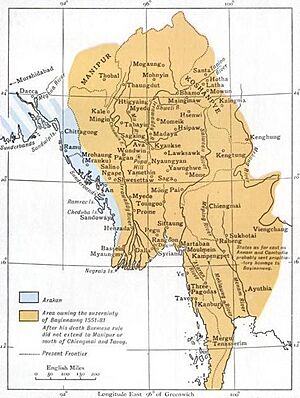
The Chinese Shan States were small territories of Shan people. They were ruled by local leaders but were under the control of China. They were also known as Koshanpye or "Nine Shan States." Some of the main states included Mönglem, Möngmāu (Mong Mao), and Keng Hung (Chiang Hung).
Much of the history of these small Tai (Dai) Kingdoms is not well known. Old stories and records about the northern Shan States have different names and dates. This makes their history hard to understand.
According to old traditions, there was a State of Pong. It is said to have started from a legendary kingdom in 58 BC. Some scholars believe the Kingdom of Pong is the same as Mong Mao.
These Shan States were often under the control of powerful Chinese empires. They gained some independence when the Dali Kingdom in Yunnan fell to the Yuan dynasty. By the 17th century, these Shan States became part of China's main territories. Their rulers were allowed to keep much of their power under a system called Tǔsī Zhìdù. In the mid-18th century, the Konbaung dynasty of Burma fought wars against the Chinese Qing dynasty. Eight of the Chinese Shan states were briefly taken by Burma. However, all these northern Shan States later remained under Chinese rule.
The former Chinese Shan States are now part of Yunnan Province in China. Under Chinese rule, the Shan people in these areas were called a "minority." They became one of many ethnic minorities in that part of Yunnan.
Images for kids
See also
- Shan people
- Wa States


